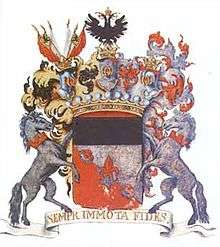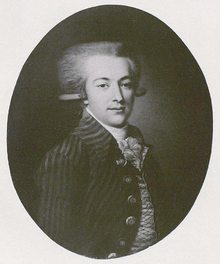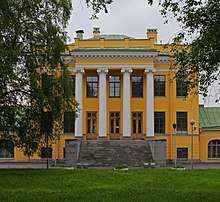Yekaterina Vorontsova-Dashkova
| Yekaterina Vorontsova-Dashkova | |
|---|---|
.jpg) Portrait of Vorontsova-Dashkova by Dmitry Levitsky (1784) | |
| Born |
Yekaterina Romanovna Vorontsova-Dashkova 28 March 1743 Saint Petersburg, Russian Empire |
| Died |
15 January 1810 (aged 66) Moscow, Russian Empire |
| Spouse(s) | Prince Mikhail Dashkov |
| Parent(s) | Roman Vorontsov |
Princess Yekaterina Romanovna Vorontsova-Dashkova (Russian: Екатери́на Рома́новна Воронцо́ва-Да́шкова;[1] 28 March [17 March O.S.] 1743[note 1] – 15 January [4 January O.S.] 1810[3]) was the closest female friend of Empress Catherine the Great and a major figure of the Russian Enlightenment.
Early life

Born Countess Yekaterina Vorontsova, she was the third daughter of Count Roman Vorontsov, a member of the Senate, and was distinguished for her intellectual gifts. Her uncle Mikhail Illarionovich and brother Alexander Romanovich both served as Imperial Chancellors, while her brother Semyon was Russian ambassador to Great Britain, and a celebrated Anglophile. She received an exceptionally good education, having displayed from a very early age the abilities and tastes which made her whole career so singular. She was well versed in mathematics, which she studied at the University of Moscow. In general literature, her favorite authors were Bayle, Montesquieu, Boileau, Voltaire and Helvétius.[4]
Catherine's coup d'état

While still a girl, she was connected with the Russian court, and became one of the leaders of the party that attached itself to the Grand Duchess Catherine Alexeyevna.
Before she was sixteen, she married Prince Mikhail Ivanovich Dashkov (1736–1764), a prominent Russian nobleman of Rurikid stock, in February 1759, and went to reside with him in Moscow.[4] She learned Russian there to communicate with her in-laws. After the death of Prince Dashkov, she gave herself up to her children, to literature, and to politics.[3]
In 1762, she was at Saint Petersburg and took, according to her own account, the leading part in the coup d'état by which Catherine was raised to the throne; however, this was discounted by Catherine in her letters.[5] Another course of events would probably have resulted in the elevation of the Princess Dashkova's elder sister, Elizabeth, who was the former emperor's mistress, and in whose favor he made no secret of his intention to depose Catherine.[4]
Foreign travels
Her relations with the new empress were not of cordial nature, though she continued to be devotedly loyal. She often disliked the men Catherine the Great chose to take as lovers, and often resented the graces and devotion shown to them by the Empress. Her blunt manners, her unconcealed scorn of the male favorites that in her eye disgraced the court, and perhaps also her sense of unrequited merit, produced an estrangement between her and the empress, which ended in her asking permission to travel abroad. Permission was granted, and shortly thereafter she departed, but remained a loyal supporter of Catherine, and the two women remained friends. The true cause of her request to leave was said to have been the refusal by Catherine the Great of her request to be appointed colonel of the imperial guards.
Her husband having meanwhile died, she set out in 1768 on an extended tour through Europe. She was received with great consideration at foreign courts, and her literary and scientific reputation procured her the entrée to the society of the learned in most of the capitals of Europe.[4]
In Paris, she secured the warm friendship and admiration of Diderot and Voltaire. She showed in various ways a strong liking for Britain and the British. She corresponded with Garrick, Dr. Blair, and Principal Robertson; and when in Edinburgh, where she was very well received, she arranged to entrust the education of her son, Pavel Michailovich, Prince Dashkov to Principal Robertson.[4] She lived in Edinburgh from 1777 to 1779, and donated a collection of Russian commemorative medals to the University of Edinburgh.[6] Her son became an adjutant of Grigory Potyomkin.[7]
She travelled in Ireland, where she can be seen watching a review of the Irish Volunteers in a picture by Francis Wheatley in November 1779. She was friends with Georgiana Shipley, daughter of Jonathan Shipley, in London. She met Benjamin Franklin in Paris on 3 February 1781.[8][9]
Exhibitions
"The Princess and the Patriot: Ekaterina Dashkova, Benjamin Franklin and the Age of Enlightenment" exhibition was held in Philadelphia, U.S.A., from February to December 2006. Benjamin Franklin and Dashkova met only once, in Paris in 1781. Franklin was 75 and Dashkova was 37. Franklin and Dashkova were both evidently impressed with each other. Franklin invited Dashkova to become the first woman to join the American Philosophical Society, and the only one to be so honored for another 80 years. Later, Dashkova reciprocated by making him the first American member of the Russian Academy. The correspondence between Franklin and Dashkova was the highlight of the exhibition.[10]
Head of Two Academies
In 1782, Dashkova returned to the Russian capital, and was at once taken into favor by the empress, who strongly sympathized with her in her literary tastes, and especially in her desire to elevate Russian to a high place among the literary languages of Europe.[4]
Immediately after her return, the princess was appointed Director of the Imperial Academy of Arts and Sciences (known now as the Russian Academy of Sciences).[4] Theoretically the head of the Academy was always its President; however, Count Kirill Razumovsky, who had been appointed President in 1746 (when he was just 18) played only a nominal role in the Academy, and the actual leadership in the Academy, such as there was, belonged to successive Directors.
Dashkova was the first woman in the world to head a national academy of sciences. Although not a scientist herself, Dashkova restored the failing institution to prominence and intellectual respectability. This came at a critical time in the history of science, its transformation from what was called natural philosophy, often practiced by gifted amateurs, to a professional enterprise.
In 1784 Dashkova was also named the first president of the newly created Russian Academy. In this position, too, she acquitted herself with marked ability. She launched the Russian Academy's project for the creation of its 6-volume Dictionary of the Russian Languages, arranged its plan, and executed a part of the work herself.[4]
In 1783 she was elected an honorary member of the Royal Swedish Academy of Sciences, the first woman among this academy's foreign members, and its second female member after Eva Ekeblad.
Shortly before Catherine's death, the friends quarrelled over a tragedy which the princess had allowed to find a place in the publications of the Academy, though it contained revolutionary principles, according to the empress. A partial reconciliation was effected, but the princess soon afterwards retired from court.[4]
Exile and legacy

On the accession of the Emperor Paul in 1796, she was deprived of all her offices, and ordered to retire to a miserable village in the government of Novgorod, "to meditate on the events of 1762." After a time the sentence was partially recalled on the petition of her friends, and she was permitted to pass the closing years of her life on her own estate near Moscow, where she died on 4 January 1810.[4]
Her son, the last of the Dashkov family, died in 1807 and bequeathed his fortune to his cousin Ivan Vorontsov, who thereupon by imperial licence assumed the name Vorontsov-Dashkov. Ivan's son, Count Illarion Ivanovich Vorontsov-Dashkov, held an appointment in the tsar's household from 1881 to 1897[4] before gaining wide renown as a General-Governor of Caucasus from 1905 to 1915.
Works
Besides her work on the Russian dictionary, Princess Dashkova edited a monthly magazine, and wrote at least two dramatic works: The Marriage of Fabian, and a comedy entitled Toissiokoff. Her memoirs were published in French in Paris in 1804 (Mon Histoire) and in English in 1840 in London in two volumes (Memoirs of the Princess Daschkaw, written by herself).[11] The English version of her memoirs was edited by Mrs. W. Bradford[4]. (This is Martha Wilmot, who lived with the princess from 1803-1808; her family missing her, elder sister Katherine Wilmot went to bring her home, but the pair decided to stay another couple of years.[12].)
See also
Notes
References
- ↑ Russian pronunciation: [jɪkətʲɪˈrʲinə rɐˈmanəvnə vərɐnˈtsovə ˈdaʂkəvə]
- ↑ Dashkova, Ekaterina Romanovna (1995). The Memoirs of Princess Dashkova. Translated by Fitzlyon, Kyril. Duke University Press. p. 31. ISBN 9780822316213. Retrieved 26 March 2018.
- 1 2

- 1 2 3 4 5 6 7 8 9 10 11 12

- ↑ Massie, Robert K., Catherine the Great: Portrait of a Woman, (Random House) New York, NY, 2011.
- ↑ "The Dashkov Medals", Edinburgh University Library, Special Collections and Archives
- ↑ Prince of princes: the life of Potemkin, Sebag Montefiore, Macmillan, 2001, ISBN 978-0-312-27815-1
- ↑ "Benjamin Franklin and Russia", The Philosophical Age p. 129
- ↑ "Benjamin Franklin and Russia", The Philosophical Age pp. 58–61
- ↑ Archived 13 January 2009 at the Wayback Machine.
- ↑ "Ekaterina Dashkova – Russiapedia History and mythology Prominent Russians". Rt.com. 16 August 1941. Retrieved 16 August 2012.
- ↑ "Wilmot-Dashkova Collection". Royal Irish Academy. 31 August 2015. Retrieved 29 May 2018.
Sources
- The princess & the patriot: Ekaterina Dashkova, Benjamin Franklin , and the Age of Enlightenment, Volume 96, Part 1, Editor Sue Ann Prince, American Philosophical Society, 2006, ISBN 978-0-87169-961-9
- Woronzoff-Dashkoff, A. Dashkova: A Life of Influence and Exile. American Philosophical Society: Philadelphia, 2008.
- The memoirs of Princess Dashkova, Editors Jehanne M. Gheith, Alexander Woronzoff-Dashkoff, Translator Kyril FitzLyon,Duke University Press, 1995, ISBN 978-0-8223-1621-3
- "Princess Ekaterina Romanovna Vorontsova Dashkova", Great Women Travel Writers: From 1750 to the Present, Editors Alba Amoia, Bettina Knapp, Continuum International Publishing Group, 2006, ISBN 978-0-8264-1840-1
External links
| Wikisource has the text of an 1879 American Cyclopædia article about Princess Dashkova. |
- The Vorontsov Virtual Museum
- Madame Directeur de l'Academie
- Brooklyn Museum Heritage Floor: Yekaterina Dashkova
- Russian Princess Stands With Franklin as Comrade of the Enlightenment
